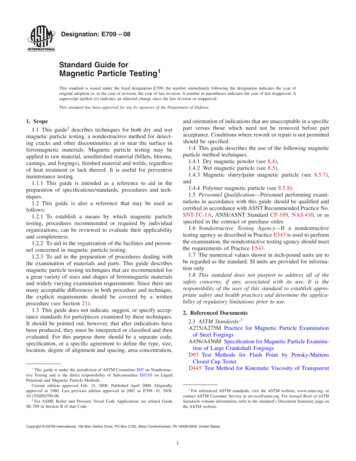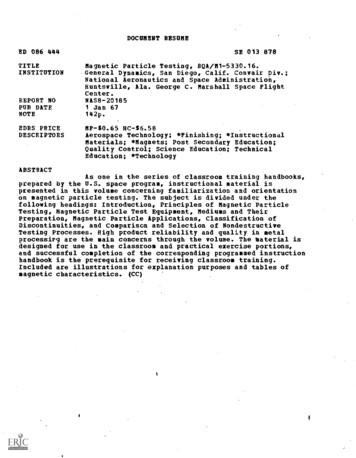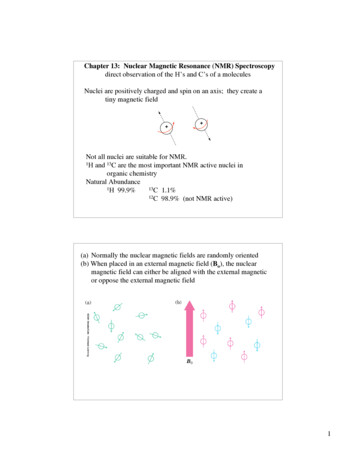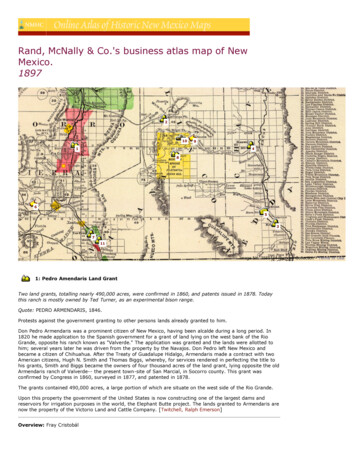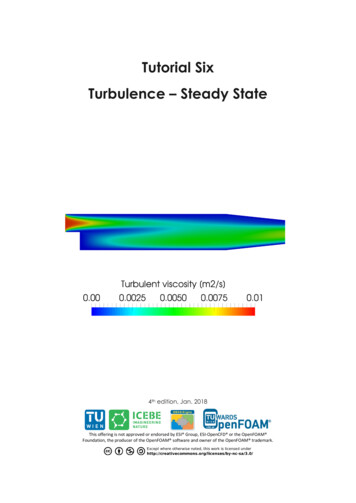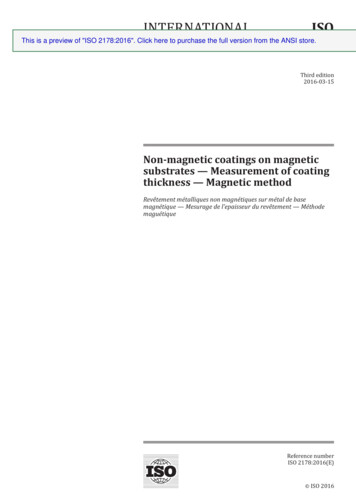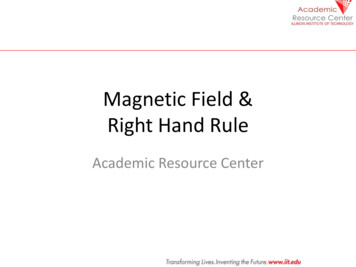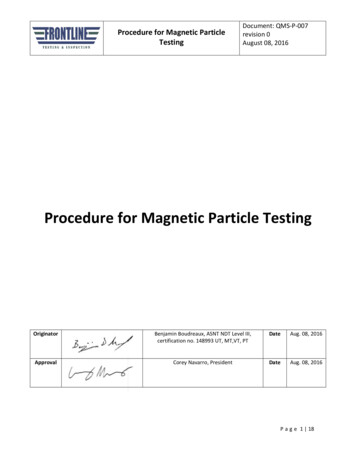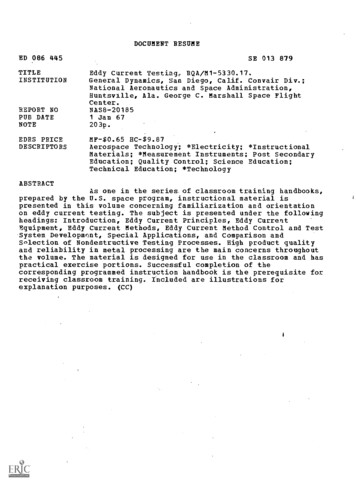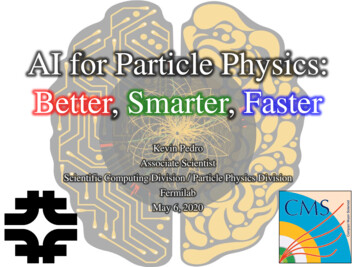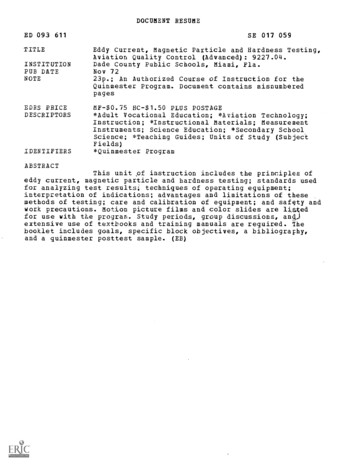
Transcription
DOCUMENT RESUMEED 093 611TITLEINSTITUTIONPUB DATENOTEEDRS PRICEDESCRIPTORSSE 017 059Eddy current, Magnetic Particle and Hardness Testing,Aviation Quality Control (Advanced): 9227.04.Dade County Public Schools, Miami, Fla.Nov 7223p.; An Authorized Course of Instruction for theQuinmester Program. Document contains misnumberedpagesMF- 0.75 HC- 1.50 PLUS POSTAGE*Adult Vocational Education; *Aviation Technology;Instruction; *Instructional Materials; MeasurementInstruments; Science Education; *Secondary School,Science; *Teaching Guides; Units of Study (SubjectFields)IDENTIFIERS*Quinmester ProgramABSTRACTThis unit ,of instruction includes the principles ofeddy current, magnetic particle and hardness testing; standards usedfor analyzing test results; techniques of operating equipment;interpretation of indications; advantages and limitations of thesemethods of testing; care and calibration of equipment; and safety andwork precautions. Motion picture films and color slides are listedfor use with the prograi. Study periods, group discussions, and)extensive use of textbooks and training manuals are required. Thebooklet includes goals, specific block objectives, a bibliography,and a quinmester posttest sample. (EB)
U 5 DEPARTNIENTOF HEALTHEDUCATION E. WELFARENATIONAL 'INSTITUTE OFEDUCATIONDOCumENT HAS BEEN REPRODOLED ExAcTLy A5 RECEvE0 , R0,4.4THE PERSON OR ORGANoZAI,ON ORIGINIV. OR OPINIONSATJ.Nc, IT POINTSSTATED DO NO: NECESSARIL V REPRESENT o; v 1CIAL NATIONAL INSTTuTE CIEnuCAT,ON PCS,' ,ON OR PM. !CYAUTHORIZED COURSE OF INSTRUCTION FOR THEUI4114101111/ftiesolsoliteb,Course OutlineAVIATION QUALITY CONTROL - ADVANCED - 9227(Eddy Current, Magnetic Particle andHardness Testing)Department 48 - Quin 9227.04C4-)GPIODIVISION OF INSTRUCTION1173
I SCPr.r\DADE COUNTY PUBLIC SCHOOLSLai1 4 5 0NORTHEAST SECOND AVENUEMIAMI,FLORIDA33132Course OutlineAVIATION QUALITY CONTROL - ADVANCED9227(Eddy Current, Magnetic Particle and Hardness Testing)Department 48 - Quin 9227.04county office ofVOCATIONAL AND i',DULT EDUCATION
THE SCHOOL BOARD OF DADE COUNTYG. Holmes Braddock, ChairmanMr. William H. Turner, Vice-ChairmanMrs. E:hel BeckhamMrs. Crutcher HarrisonMrs. Phyllis MillerMr. Robert RenickDr. Ben SheppariDr. E. L. Whigham, Superintendent of SchoolsDade County Public SchoolsMiami, Florida 33132November, 1972Published by the Schodl Board of Dade County
Course Description922748State CategoryNumberCounty Dept.Number9227.04County CourseNumberEddy Current, Magnetic Particleand Hardness TestingCourse TitleThis course includes the principles of eddy current, magnetic particle and hardnesstesting; standards used for analyzing test results; techniques of operating equipment; interpretation of Indications; advantages and limitations of these methodsof testing; care and calibration of equipment and safety and work precautions.Clock Hours:135
PREFACEThe following quinmester course outline will serve as a guide forthe high school or adult trainee in the use and care of eddy current,magnetic particle, and hardness testing equipment.This equipment isused in nondestructive testing applications.This outline consists of eight blocks of instruction which aresubdivided into several units each.These blocks will involve the tech-niques of operating, testing, and calibrating eddy current, magneticparticle and hardness testing equipment.Interpreting the indications,safety and work precautions and maintenance will also be covered.Thiscourse is 135 hours in length.Adequate laboratory time and actual experience on aircraft and otherequipment will he provided to develop skills in the student.The student is expected to be proficient, not just familiar withthe nature and the application of these techniques.The student will work with and receive substantial drill in the useof actual equipment used in the NDT field.Motion picture films and color slides will be used YC bring intothe classroom the application of these techniques.Study periods, group discussions, and extensive use of textbooks andtraining manuals will he used.These are listed along with referencesand periodicals.This outline was developed through the cooperative efforts of theinstructional and supervisory personnel, the Quinmester Advisory Committeeand the Vocational Curriculum Materials Service, and has been approved bythe Dade County Vocationr1 Curriculum Committee.
TABLE OF CONTENTSwith Suggested Hourly BreakdownPagePREFACEivGOALSSPECIFIC BLOCK OBJECTIVESBIBLIOGRAPHY5BLOCKI.II.THEORY OF EDDY CURRENT TESTING (5 Hours)Definition of Eddy CurrentFactors Affecting Eddy Current TestingDirection and Distribution of Eddy Current in PartBeing Tested111.EDDY CURRENT TESTING EOUIPMENT (5 Hours)Sensing SystemIndicating Instrument (Magnatest ED-520)1,III.1EDDY CURRENT TESTING TECHNIQUES (30 Hours)Setting Up the EquipmentReading Meter IndicationsAdvantages and Limitations of Eddy Current TestingCare and Maintenance of Eddy Current Equipment11.IV.V.VI.MAGNETIC PARTICLE TESTING PRINCIPLES (15 Hours)Theory of MagnetismMagnetic MaterialsElectrically Induced Magnetic FieldsMagnetizing Current CharacteristicsDemagnetization222222MAGNETIC PARTICLE TESTING EOUIPMENT (10 Hours)Wet Horizontal EquipmentPortable EquipmentDemagnetizing :nuipmontMediums and Their Preparation2333TECHNIOUES IN TESTING .11TH MAGNETIC PARTICLE INSPECTIONEQUIPMENT (50 Hours)Materials and Specimens Capable of Being TestedSetting Up Equipment Prior to Test.33Preparation of ':specimen for Test3Magnetizing the ThecimenApp Lying the Particles to the Specimen33Interpretation :IC In.I''ationsTechniques ofAdvantagestJper. -cTgnetizing of SpecimensIL-ations of Magnetic ParticleTestir-,1-1c. precautionsSafety andCare an0 :::iteu,m:e of Equipmentii3.3444
PageVII.HARDNESS TESTING OF MATERIALS AND SPECIMENS (20 Hours)Relationship of Hardness, Heat Treatment and TensileStrengthMethods of Hardness TestingPrinciple of the Rockwell Hardness TestTechniques in Operating the Rockwell HardnessTesterPreparation and Supporting the Specimen for TestApplying the Minor LoadApplying the Major LoadReleasing the Major LoadReading the Proper Scale on the DialCalibrating the InstrumentCare and Maintenance of Instrument.VIII,444.44444444QUINMESTER POST-TESTAPPENDIX:OUINMESTER POST-TEST SAMPLEiii7
GOALSThe student must be able to:1.Develop skills in the use of eddy current, magnetic particle, andhardness testing equipment for nondeotructive testing.2.Develop the attitudes of patience and persistence to gain maximumaccuracy.3.Develop the habits of cleanliness of person and work area.4.Be aware of the responsibility involved in his chosen work.5.Maintain the standards required for the field.6.Control quality of the finished product.iv
SPECIFIC BLOCK OBJECTIVESBLOCK I - THEORY OF EDDY CURRENT TESTINGThe student must be able to:Explain the basic principle of eddy current testing.Show by diagram, eddy current patterns induced by a surface coil,by an inside coil.1.2.BLOCK II - EDDY CURRENT TESTING EQUIPMENTThe student must be able to:Illustrate, on paper, test coil arrangement for surface coil andinside coil probes.Explain the purpose of each control on the ED-520 instrument1.2.panel.BLOCK III - EDDY CURRENT TESTING TECHNIQUESThe student must be able toet up the ED-520 instrument and adjust lift-off and balance.Calibrate instrument against a known standard.Run a test on at least three specimens with known defects andinterpret results.Discuss with the instructor the advantages aad limitations ofthe method of nondestructive testing.Demonstrate proper care and maintenance of the ED-520 instrumentand accessories.1.2.3.4.5.BLOCK IVMAGNETIC PARTICLE TESTING PRINCIPLESThe student must be able to:1.2.3.4.5.6.7.8.9.10.11.Explain and discuss with instructor the basic theory of magnetism.Show by diagram, magnetic lines of force produced by longitudinalmagnetization of a specimen.Show by diagram, magnetic lines GE force produced by circularmagnetization.Illustrate a leakage field in a magnetized part.List a group of ferromagnetic materials.Name at least three materials of a diamagnetic nature.Name at least three materials of a paramagnetic nature.Explain the "right hand rule."solve at least three problems involving selection of proper currentusing the L/D ratio and ampere terms.List at least three reasons where demagnetization of a part is notnecessary.List at least three reasons where demagnetization of a part isnecessary.
BLOCK V - MAGNETIC PARTICLE TESTING EQUIPMENTThe student must be able to:1.2.3.Explain to the instructor the major parts and the operation ofthe controls of a wet horizontal machine.Demonstrate the operation of the demagnetization machine.Make up a bath containing the proper concentration of particlesfor fluorescent or visable light use.TECHNIQUES IN TESTING WITH MAGNETIC PARTICLE INSPECTION EQUIPMENTBLOCK VIThe student must be able to:I.2.3.4.5.Prepare and test at least three specimens with known defects bythe longitudinal method and interpret the indications.Prepare and test at least three specimens with known defects bythe circular method and interpret the indications.Demonstrate the dry method of particle application.Demonstrate the wet continuous method of particle application.Demagnetize a specimen and show by indication that it is completelydemagnetized.BLOCK VIIHARDNESS TESTING OF MATERIALS AND SPECIMENTSThe student must be able to:1.2.3.4.Explain the basic principles of three systems of hardness testing.Set up the Rockwell Hardness Tester and determine the hardness ofat least four specimens of different shape and degree of hardness.Translate the scale reading into tensile strength and the hardnessnumbers of other systems.Calibrate the Rockwell Hardness Tester using the calibration blocksprovided with the instrument.Measure conductivity of at least three unknown specimens of metaland compare with known specimens to determine hardness.Use theFM-120 instrument.vi
Course OutlineAVIATION QUALITY CONTROLADVANCED - 9227(Eddy Current, Magnetic Particle and Hardness TestingDepartment 48 - Quin 9227.04I.II.THEORY OF EDDY CURRENT TESTINGA.Definition of Eddy CurrentsB.Factors Affecting Eddy Current Testing1.ConductivityPermeability2.C.Direction and Distribution of Eddy Current in Part Being TestedEddy currents induced by encircling coil1.Eddy currents induced by inside coil2.Eddy currents induced by surface coil3.Depth of eddy current penetration4.EDDY CURRENT TESTING EQUIPMENTA.B.Sensing SystemTest coil arrangement:1.a.Surface coilb.Inside coilTest coil leads2.Indicating Instrument (Magnatest ED-520)Lift-off frequency controlBalance control2.Selector switch3.Indicating meter4.Battery charging system5.1.III.EDDY CURRENT TESTING TECHNIQUESA.Setting Up the EquipmentAdjusting lift-off1.Checking against standard2.B.Reading Meter IndicationsProbe position1.Balance control2.C.Advantages and Limitations of Eddy Current TestingDepth penetration1.Materials that can be tested2.Indications and read out3.
D.IV.Care and Maintenance of Eddy Current Equipment1.Charging batteries2.Repairing and making probesMAGNETIC PARTICLE TESTING PRINCIPLESA.Theory of MagnetismMagnetic poles1.Magnetic field2.Lines of force3.Leakage field4.Longitudinal magnetization5.6.Circular magnetizationB.Ma,netic MaterialsFerromagnetic materials1.Diamagnetic materials2.3.Paramagnetic materialsC.L:lectrically Induced Magnetic Fiele-;1.2.3.4.5.6.7.V.Right hand ruleMagnetic fluxFlux densityPermeabilityReluctanceResidual magnetismRetentivityD.Magnetizing Current CharacteristicsAlternating current1.Half and full wave rectification2.Penetration characteristics3.4.Current requirementsa.Length versus diameter ratiob.Correct amperage for part sizeE.DemagnetizationAlternating current for demagnetization1.Direct current for demagnetization2.3.When and when not necessary to deulagnetizeField strength meter to indicate demagnetization4.MAGNETIC PARTICLE TESTING EnUIPMENTA.Wet Horizontal EquipmentHead stock and tail stock1.Using the coil2.Meters and pilot lights3.Current regulating switch4.5.Pump and nozzle for bath applicationUltravioletlight operation6.7.Transfer switch positionsCurrent source8.-2-
V.MAGNETIC PARTICLE TESTING EQUIPMENT (Contd.)a.b.B.C.TransformerRectifierPortable Equipment1.Electromagnetic yokePowder and bath applicators2.3.Ultraviolet lightDemagnetizing EquipmentA.C. current coilTimer and indicating light2.I.D.VI.Mediums and Their Preparation1.Fluorescent and visible light particlesWet suspension2.a.Selection of colorb.Type of bathc.Concentration of particles in bath1.Use of centrifuge tubeAgitation of bath2.3.Dry application of particlesa.Use of applicatorsh.Color selectionTECHNIQUES IN TESTING WITH MAGNETIC PARTICLE INSPECTION EOUIPMENTA.Materials and Specimens Capable of Being TestedB.Setting Up Equipment Prior to TestC.Preparation of Specimen for TestD.Magnetizing the specimenerforming the longitudinal magnetization.1.Performing circular magnetization2.E.Applying the Particles to the SpecimenDry method of application1.Wet method of application2.a.Continuous techniqueb.Residual techniqueF.Interpretation of IndicationsVisible light indications1.Fluorescent light indications2.Using standards3.G.Techniques of Prop,!r Demagnetizing of Specimens1.Using A.C. or D.C. current for demagnetizationMethods of detecting complete demagnetization2.-3-
VII.VIII.H.Advantages and Limitations of Magnetic Particle TestingI.Safety and ,fork Precautions1.Handling the pa.rticles and baths2.Operating the equipmenta.Electrical ;hock hazardb.Physical burn hazardJ.Care and Maintenance of Equipment1.Cleaning of electrical terminals2.Periodic draining and cleaning of tank pump hose and nozzle3.Lubrication of air cylinderHAFDNESS TESTING OF MATERIALS AND SPECIMENSA.Relationship of Hardness, Heat Treatment and Tensile StrengthB.Methods of Hardness Testing1.The Rockwell system2.The Brinell systemThe Shore Scleroscope3.4.Using the conductivity testerC.Principle of the Rockwell Hardness Test1.The penetratorMinor load2.Major load3.Measure of penetration into material4.Dial indications5.D.Techniques in Operating the Rockwell Hardness TesterSelecting the proper scale1.Selecting the penetrator2.Matching the weights to scale and penetrator3.E.Preparation and Supporting the Specimen for TestF.Applying the Minor LoadC.Applying the Major LoadH.Releasing the Major LoadI.Reading the Proper Scale on the DialJ.Calibrating the Instrument1.Use of calibration blocksAdjustment on the instrument2.K.Care and Maintenance of InstrumentServicing the dash-pot1.Lubrication2.OUINMESTER POST -TEST-4-
BIBLIOGRAPHY(Eddy Current, Magnetic Particle and Hardness Testing)Basic References:1.Nondestructive Testing, Eddy Current Testing. Classroom TrainingSan Diego: General Dynamics Convair Division,Handbook.1967.2.Pp. 203.Nondestructive Testing, Magnetic Particle Testing.ClassroomTraining Handbook.General Dynamics ConvairSan Diego:Division, 1967.Pp. 144.Supplementary References:3.Berger, Harold.Nondestructive Testing. Oak Ridge, Tennessee:USAEC Division of Technical Information Extension, 1967.Pp. 38.4.Betz, C.5.Duane and Betz.Principles of Magnaflux. 3rd ed.Magnaflux Corporation, 1941. Pp. 525.6.An Outline of Metallurgical Practice. 3rd ed.Hayward, C. R.Princeton, New Jersey:D. Van Nostrand Company, Inc., 1961.Pp.728.7.Nondestructive Testing Handbook.McMaster, Robert.Two Volumes.New York: Ronald Press Company, 1963.Pp. 540 and 420.8.Nondest.ictive Testing Methods.Technical Manual T.O. 33B-1-1.Washington, D.C.:U.S. Government Irinting Office, 1967.Pp. 320.9.Seybolt, A. V., and Burke, J. E.Procedures in ExperimentalNew York:Metallurgy.John Wiley and Sons, Inc., 1953.Principles of Magnetic Particle Testing.E.Magnaflux Corporation, 1967. Pp. Extension Course Institute,Chanute Air Force Base, n.d.Pp. 80.10.Testing.11.Weeks, William R. Metallurgy.4th ed.Technical Society, terial Evaluat ion.tive Testin.Monthly.-5-American Society for Nondestruc-
Films:1.Drama of Metal Forming, The.16 mm.Shell Oil Co. Film Library.2.16 mm.Hardness Testing:Rockwell.B/W.Material Lab. Audiovisual Center.3.Modern Steel Making, United States Steel.Associate Sterling Films.Sound.4.Quality Assistance.16 mm.Baker Aviation School.19 min.-6-28 min.Color,Lindsey HopkinsSound,16 mm.Color.Sound.32 min.Sound.Color.George T.
eSe0.
Quinmester Post-TestNameDateScoreMultiple Choice Test ItemsEach statement has one right answer.Place the letter of your choicein the space provided on the left side of the statement.1.Indications caused by leakage fields due to internal splines,keyways, and drilled-holes close to a test surface are:a.b.c.d.2.Which is the most sensitive:a.b.3.a.c.d.b.c.d.Saturation pointMagnetic fieldFerromagneticParamagneticPermeability is the ease with which a metal or metallic part canbe magnetized.a.b.6.Head shotProds at either endCentral conductor placed between contact headsCylinder placed crosswise in solenoidThe space within and surrounding a magnetized part or conductorcarrying a current is known as:a.5.Continuous methodResidual methodHow is the inside diameter of a cylinder best magnetized:b.4.DefectsNonrelevantMagnetic writingBoundary zonesTrueFalseThe magnetism which remains in a piece of magnetizable materialafter the magnetizing, force has been removed is called residual.a.b.TrueFalse-9-
7.The areas on a magnetized part from which th., marnotc field is leavingor returning into the part is called:a.b.c.d.8.The strength of a magnetic field is known uxmaticDiamagneticWhat group of materials is most strongly affected by magnetism andmay be inspected by magnetic particle inspection:a.Diamagnetich.Alloysc.FluxmaticNickel based metalsd.13.TrueFalseWhat group of materials is repelled by magnets:b.12.Subsurface defect.Surface defectThe defect indication is strongest when the magnetic field is at a900 angle to the defect.b.11.Flux densityFerromagneticMagnetic polesCoercive forceA sharp well defined indication is most likely to be:b.10.Salient pointsDefectsMagnetic polesFieldWhen the flux lines or lines of force traverse the part in a directionessentially parallel to the long axis of the test piece, the lines offorce tend to return through the air from one pole to the other formingThis is known as what type of magnetization:a closed magnetic uous-10-
14.When longitudinally magnetizing a part in a coil, how is theeffective amperage determined:c.Amps applied multiplied by number of turns in a coilNumber of turns in coil multiplied by width of partAmperage indicated by ammeterd.I Ea.b.R15.Through what medium are discontinuities demonstrated in magneticparticle inspection:a.b.c.d.16.When the finely divided ferromagnetic particles are in oilsuspension, the test method is called:a.b.c.d.17.Finely divided ferromagnetic particles of high permeability,low coercive force and very high retentivityFinely divided ferromagnetic particles of high permeabilityand low retentivityRed oil like substance with good capillary actionMetal shavings and particlesOil and whiting techniqueOil suspension techniqueWet methodSpray or dip methodInspecting a part by magnetizing then applying the medium iscalled:a.b.c.d.18.Subjecting the part to a magnetic field that is constantlyreversing in polarity and gradually diminishing in strengthaccomplishes which of the following:a.b.c.d.19.20.Continuous methodWet methodResidual methodDry methodMagnetizes the partRemoves residual field from the partSoaks in the flux densityHelps find deep lying defectsTo detect a seam in bar stock running parallel with the longitudinal axis, you would use the circular method.a.Trueb.FalseThe magnetic Field surrounding a bar magnet is most dense:a.b.c.Near middle r)r magnetAt ends of magnetOne foot from magnet
21.To locate defects, part should be magnetized so that the long axisof possible defects:a.b.22.Is at right angles to lines of forceIs parallel to lines of forceWhen electric current is parsed through a coil, the direction ofthe lines of flux induced in a rod positioned within the coil is:CircularUnknownc.Longitudinald.' Vectora.b.23. The fluorescent magnetic particle inspection method is the same asthe standard magnetic particle method except for:a.b.c.d.24.After wet magnetic particle inspection, a rinse bath is necessary:a.b.c.25.a.Sharp and distinctb.'elide and indefinitec.Criss crossHigh and FuzzyAn eddy current is a circulating electrical current induced in aconducting article by:a.b.d.27.To remove magnetic particlesTo aid in removing remnat magnetismTo provide lubricationNot necessaryA surface defect produces an indication which is:d.26.Black li;htHigher currentDifferent machineFluorescent material in suspensionGamma raysAn alternaLing magnetic fieldA piezoelectric forceAny of the aboveThe conductivity of a material can he changed by changing:a.b.c.d.TheTheTheAllalloy of the specimenheat treatment of the specimentemperature of the specimenof the above-12-
28.When testing plate with a probe coil, it is noted that the eddycurrent output indication varies as the distance from the coilto the surface of the test part varies. The term used todescribe this action is:a.b.c.d.29.Eddy current test coils which are wound to form a narrow coilwould normally be used to detect:a.b.c.d.30.Fill-factorLift-offPhase differentiationEdge effectSlow changes in dimensionsGradual changes in conductivityVariations in heat treatmentSmall surface defectsWhich of the following could not be tested by the eddy currenttesting method:a.b.c.d.A 4-inch thick plate to be tested for discontinuities throughout the plateTubing to be tested for surface cracksRod to be tested for laps and seamsTubing to be tested for variation in outside diameterEssay Questions1.Name three methods of hardness testing.2.In relation to the Rockwell Hardness tester, what is the "brail"?3.What is the basis4.How is the minor load applied?5.What do the letters % LACS stand for on the FM-120 conductivity tester?the Rockwell Hardness test?
ANSWER KEY FOR QUINMESTER POST-TESTMultiple Choice Test 14.a29.d15.a30.aEssay Questions1.Rockwell, Brinell, Shore Scleroscope2.A diamond pointed penetrator3.Linear measurement of depth of penetration between major and minorload4.Raising the elevator with specimen against penetrator until smallindicator on dial points vertically to black dot5.Percent of international annealed copper standard-15-
9227 48 9227.04 and Hardness Testing State Category County Dept. County Course Course Title Number Number Number. This course includes the principles of eddy current, magnetic particle and hardness testing; standards used for analyzing test results; techniques of operating equip- ment; interpretation of Indications; advantages and limitations of these methods
